Johann Ender
| Johann Ender | |
|---|---|
 Etching by Franz Xaver Stöber, 1852 |
Johann Nepomuk Ender (3 November 1793 Vienna – 16 March 1854 Vienna) was an Austrian painter.
Biography
As a portrait painter, he was successful at an early age. He studied at the Vienna Academy, and when he had hardly attained his majority won its four leading prizes. In 1818-1819, he joined Count Szecheni of Hungary on a tour of Turkey and Greece. In 1820, he went to Italy, and in Florence and Rome produced a number of works from Biblical and historical subjects. After spending a year in Paris, he returned to Vienna in 1827, where devoted his attention to miniature and historical paintings, being professor at the Academy from 1829 to 1850.
Works
Among his works are:
Fresco in the Vienna Cathedral (1853)
- “Madonna with Slumbering Christ Child” (Vienna Museum)
- “Marcus Aurelius on His Death Bed” (1814, Esterhazy Gallery)
- “The Crucifixion”, his masterpiece (a fresco in the Vienna Cathedral)
- “Orestes Pursued by the Furies” (1815)
- “Minerva Showing Ithaca to Ulysses” (1816)
- “Assumption” (1817)
- “Sleeping at Christ's Sepulchre” (1817)
- “Judith” (exhibited in 1824)
- “Miguel I of Portugal” (1827) (in the Queluz Palace)
- “From Darkness, the Light” or “Allegory of the Hungarian Academy of Sciences” (1831)
- “Bacchus Finding Ariadne”
Also notable is his great cartoon of the entry of Christ into Jerusalem.
Notes
References


This article is issued from
Wikipedia.
The text is licensed under Creative Commons - Attribution - Sharealike.
Additional terms may apply for the media files.